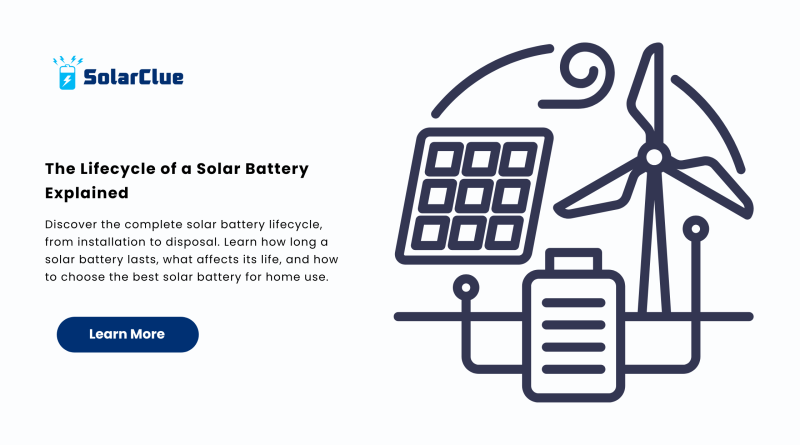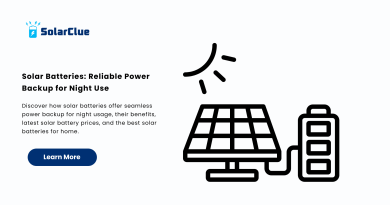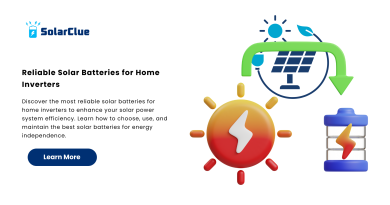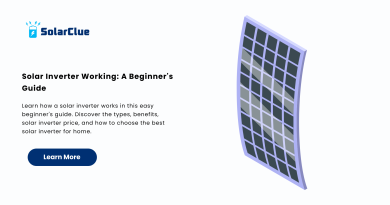The Lifecycle of a Solar Battery Explained
As the world shifts toward clean energy, solar batteries have become essential for homes and businesses looking to store solar power efficiently. But how long do these batteries really last? What can you do to extend their lifespan? In this detailed guide, we will explore the solar battery lifecycle, uncover the factors affecting their durability, and help you make smarter decisions when choosing the best solar battery for home.
Table of Contents
- 1 What Is a Solar Battery?
- 2 Understanding the Solar Battery Lifecycle
- 3 Types of Solar Batteries and Their Lifespan
- 4 How to Extend Solar Battery Life
- 5 Signs Your Solar Battery Needs Replacement
- 6 Choosing the Best Solar Battery for Home
- 7 Cost of a Solar Battery in India
- 8 Environmental Impact of Solar Battery Lifecycle
- 9 FAQs
What Is a Solar Battery?
A solar battery stores the excess electricity generated by your solar panels during the day so that you can use it at night or during power outages. It helps reduce your dependency on the grid and increases energy self-sufficiency. Whether you’re living in a city apartment or a rural home, a solar battery for home can significantly cut your electricity costs.
Understanding the Solar Battery Lifecycle
The solar battery lifecycle refers to the stages a battery goes through from the moment it is installed to the end of its usable life. A typical solar battery lasts between 5 to 15 years, depending on its type, usage, and maintenance.
Let’s break down the lifecycle into five key stages:
1. Installation and Commissioning
This is the starting point. Once you’ve selected the best solar battery for your setup, it is installed and configured to work with your solar panel system and inverter. Proper installation is crucial to ensure efficiency and safety.
Pro tip: Choose a professional installation service to avoid performance issues and warranty voids.
2. Initial Performance Period
In the first few years, your solar battery performs at optimal capacity. You’ll experience full charge and discharge cycles with maximum efficiency. This is also when your warranty (usually 5-10 years) is most effective.
3. Mid-Life Degradation
After around 5-7 years, your battery will start to degrade. Its ability to hold a full charge will reduce slightly each year. This process is called capacity fade, and it’s a natural part of the solar battery lifecycle.
Factors that affect this stage include:
-
Depth of Discharge (DoD)
-
Battery temperature
-
Usage cycles per day
-
Quality of the battery and inverter compatibility
4. End-of-Life Period
When your solar battery can no longer hold a sufficient charge (usually around 60-70% of its original capacity), it’s considered to be at the end of its life. However, some batteries can still function in a reduced capacity for backup purposes.
5. Recycling or Disposal
Disposing of a solar battery responsibly is crucial for environmental safety. Some manufacturers offer take-back programs, while certified recycling centers can recover valuable materials like lithium, lead, and cobalt.
Types of Solar Batteries and Their Lifespan
Different battery technologies affect how long your solar battery life will last.
| Battery Type | Typical Lifespan | Efficiency | Maintenance |
|---|---|---|---|
| Lithium-ion | 10-15 years | 90-95% | Low |
| Lead-acid | 5-8 years | 80-85% | Moderate |
| Flow batteries | 10+ years | 70-80% | Low |
Lithium-ion batteries are currently considered the best solar battery option due to their long life and high efficiency.
How to Extend Solar Battery Life
To get the most out of your solar battery for home, follow these tips:
-
Avoid deep discharges: Use only a portion of your battery capacity regularly.
-
Control temperature: Install in a well-ventilated area to avoid overheating.
-
Routine checks: Ensure the connections are clean, secure, and corrosion-free.
-
Use smart inverters: Optimize charge and discharge cycles automatically.
Signs Your Solar Battery Needs Replacement
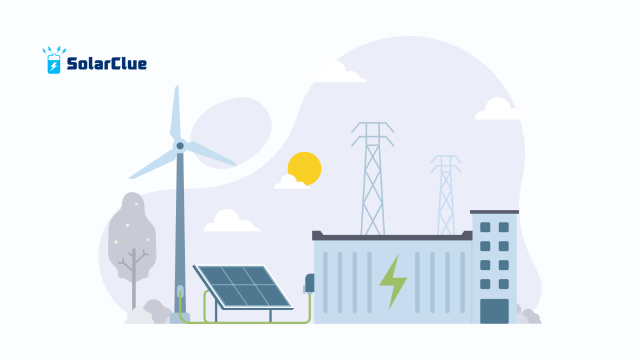
Watch out for these common indicators:
-
Noticeable drop in backup duration
-
Frequent system shutdowns
-
Longer charging time
-
Physical swelling or leakage (in case of lead-acid batteries)
If your battery shows any of these signs, it may be time to invest in a new one.
Choosing the Best Solar Battery for Home
Here are a few factors to consider when selecting the best solar battery:
-
Battery capacity (kWh)
-
Depth of Discharge (DoD)
-
Round-trip efficiency
-
Brand reputation and warranty
-
Compatibility with your solar inverter
Some popular options in India include Exide, Luminous, Amaron, and Tesla Powerwall for premium setups.
Cost of a Solar Battery in India
The cost depends on the battery type, capacity, and brand. Here’s a quick overview:
| Battery Type | Approximate Cost (INR) |
|---|---|
| Lithium-ion (5kWh) | ₹1,00,000 – ₹2,50,000 |
| Lead-acid (5kWh) | ₹30,000 – ₹70,000 |
| Tubular battery (4kWh) | ₹20,000 – ₹50,000 |
Though lithium-ion batteries have a higher upfront cost, they offer better value over time due to longer life and lower maintenance.
Environmental Impact of Solar Battery Lifecycle
It’s not just about energy savings. Choosing a sustainable battery solution helps reduce carbon emissions and dependency on fossil fuels. By properly recycling your old batteries, you support a cleaner ecosystem.
FAQs
Q1: What is the average solar battery life?
A1: Most solar batteries last between 5 to 15 years, depending on the type and usage patterns.
Q2: How can I increase my solar battery lifecycle?
A2: Avoid full discharges, control operating temperature, and perform regular maintenance checks.
Q3: Which is the best solar battery for home use?
A3: Lithium-ion batteries are considered the best solar battery due to their high efficiency and longer life span.
Q4: Do solar batteries require maintenance?
A4: Lithium-ion batteries require minimal maintenance, while lead-acid batteries need periodic checks and fluid top-ups.
Q5: Can solar batteries be recycled?
A5: Yes, most solar batteries can be recycled through certified facilities to recover valuable materials.
If you’re considering a solar battery for your home or business, understanding its full lifecycle is key to making a smart investment. From choosing the right type to maintaining it well and finally recycling it responsibly, every stage plays a role in optimizing your solar battery life.
Explore more insights and the best solar battery solutions tailored for you at 👉 solarclue.com and for expert blogs visit 👉 blog.solarclue.com – let’s power your future, sustainably!

